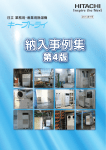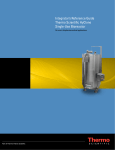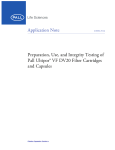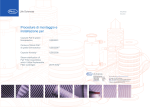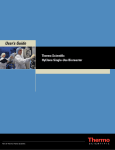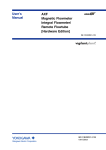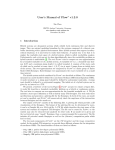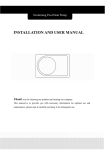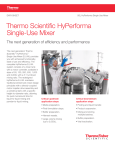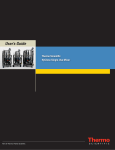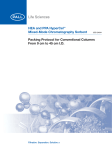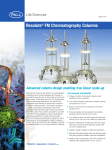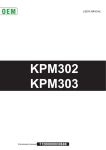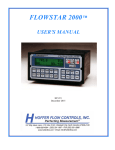Download USD 2833 Instructions For Use Pegasus™ SV4
Transcript
Instructions For Use USD 2833 Pegasus™ SV4 Virus Removal Filter Cartridges and Kleenpak™ Nova Filter Capsules with Pegasus SV4 Virus Removal Filter Membrane Contents Introduction.......................................................................................................................3 Section A – Pegasus SV4 Virus Removal Filter Cartridges for use with Pall Advanta Housings .....................................................................................................3 1. Specifications ...................................................................................................................3 2. Typical Process Steps ......................................................................................................4 2.1 Receipt of Equipment ..................................................................................................4 2.2 Filter Installation ............................................................................................................5 2.3 Filter Assembly Wetting and Filling ................................................................................6 2.4 Filter Flushing................................................................................................................8 2.5 Sterilization (Optional)....................................................................................................9 2.6 Pre-Use Integrity Testing ............................................................................................10 2.7 Conditioning the Filter and Process Filtration ..............................................................10 2.8 Product Recovery by Flushing with a Compatible Fluid ..............................................11 2.9 Preparing Filters for Post-Use Integrity Testing ............................................................11 2.10 Post-Use Integrity Test Flushing ................................................................................11 2.11 Post-Use Integrity Testing ........................................................................................11 Section B – Kleenpak Nova Filter Capsules with Pegasus SV4 Virus Removal Filter Membrane .............................................................................................................12 1. Specifications .................................................................................................................12 2. Typical Process Steps ....................................................................................................13 2.1 Receipt of Equipment ................................................................................................13 2.2 Installation ..................................................................................................................13 2.3 Filter Assembly Wetting and Filling ..............................................................................14 2.4 Filter Flushing..............................................................................................................16 2.5 Sterilization (Optional)..................................................................................................17 2.6 Pre-Use Integrity Testing ............................................................................................18 2.7 Conditioning the Filter and Process Filtration ..............................................................18 2.8 Product Recovery by Flushing with a Compatible Fluid ..............................................19 2.9 Preparing Filters for Post-Use Integrity Testing ............................................................19 2.10 Post-Use Integrity Test Flushing ................................................................................19 2.11 Post-Use Integrity Testing ........................................................................................19 Section C – Further Information and Guidance ............................................................20 1. Flushing Volumes ...........................................................................................................20 2. Further Guidance for Integrity Testing ..........................................................................20 3. Filter Return Procedure..................................................................................................21 4. Frequently Asked Questions..........................................................................................21 5. Customer Service ...........................................................................................................23 6. Pall Publications .............................................................................................................23 2 Introduction The following procedures must be followed for the installation of Pall® pharmaceutical-grade Pegasus SV4 virus removal filter cartridges for use with Pall Advanta housings, and Kleenpak Nova filter capsules with Pegasus SV4 Virus Removal Filter Membrane. Pegasus SV4 filters are direct flow filters that remove viruses essentially by size exclusion. Due to the small pore size required to remove viruses, these filters exhibit lower liquid flow characteristics when compared to filters and capsules utilizing sterilizing-grade membranes. These flow rates may influence several aspects of use including wetting and subsequent operation. Pall also provides fully automated integrated virus filter systems that provide the highest level of process safety and efficiency. These systems offer precise and consistent automated process steps for improved process efficiency and reduced labor costs. The instructions contained in the product documentation contain valuable information gained by extensive experience and should be read thoroughly. It is important that all instructions are carefully followed, and where appropriate, they should be incorporated into the end user’s standard operating procedures. Where these procedures do not suit your needs, please contact Pall or your local distributor before finalizing your system or process. Use of the product in a manner other than in accordance with Pall’s current recommendations may lead to injury or loss. Pall cannot accept liability for such injury or loss. Section A – Pegasus SV4 Virus Removal Filter Cartridges for use with Pall Advanta Housings The following information is only intended as a guide. It contains a set of recommendations for a basic mode of operation and is not intended to discuss all possible process variables. For more information or technical support, see Section C. 1. Specifications Operation outside the specifications and with fluids incompatible with construction materials may cause personal injury and result in damage to the equipment. Incompatible fluids are fluids which chemically attack, soften, swell, stress attack or adversely affect the materials of construction. Please check the datasheet and product label or contact Pall for further guidance if required. European Directive 94/9/EC (ATEX) ‘Equipment For Use In Potentially Explosive Atmospheres’ Pall filter cartridges comply with the ATEX directive when installed in a compliant Pall filter housing or assembly, but are not themselves required to be labelled with the ATEX marking. Under the terms of the directive, filter cartridges are not considered to be equipment which is capable of autonomous function, but may be thought of as components which are essential to the operation of the equipment. As such, the conformity of the filter cartridges has been assessed as an integral part of the overall assembly. www.pall.com/biopharm 3 2. Typical Process Steps A typical process flow includes but may not be limited to: 2.1 Receipt of Equipment 2.2 Filter Installation 2.3 Filter Assembly Wetting and Filling 2.4 Filter Flushing 2.5 Sterilization (optional) 2.6 Pre-use Integrity Testing 2.7 Conditioning the Filter and Process Filtration 2.8 Product Recovery by Flushing with a Compatible Fluid 2.9 Preparing Filters for Post-Use Integrity Testing 2.10 Post-use Integrity Test Flushing 2.11 Post-use Integrity Testing Ultimately, the procedures used must satisfy any process-specific validation requirements. 2.1 Receipt of Equipment 1. Store the filter cartridge in clean, dry conditions between 0 °C and 30 °C (86 °F) without exposure to irradiation sources like direct sunlight, and wherever practical in the packaging as delivered 2. DO NOT remove from packaging until just before installation 3. Check that the bag or packaging is undamaged prior to use 4. Ensure that the type of filter cartridge selected is suitable for the application 5. In addition to the part number, each filter cartridge is identified by a unique identification batch and a unique serial number 6. Every filter is identified by a part number with lot and unique serial number also provided as a two-dimensional (2D) bar code* for complete traceability of manufacturing history and for user’s traceability system. Pegasus SV4 virus removal filter cartridges are manufactured under a Quality Management System certified to ISO 9001:2008 Figure 1 Palltronic® Flowstar integrity test instrument and Palltronic bar code reader* *The Palltronic Barcode Reader is ideal for use with Palltronic Flowstar filter integrity test instruments and can read and interpret a variety of one-and two-dimensional barcodes. 4 2.2 Filter Installation Single Open-ended Plug-in Style Filter Cartridges Pegasus SV4 virus removal filter cartridges are high-quality products manufactured to exacting standards. It is essential to take care when handling and installing them into filter housings. Before installation,it is essential to verify that the filter cartridge type selected is suitable for the fluid to be filtered and to follow the appropriate instructions listed below. 1. Open the plastic bag, taking care not to damage the filter cartridge inside Caution: Avoid use of sharp blades or pointed instruments that could damage the filter cartridge and potentially damage the filter. Do not open bag by forcing the filter cartridge through the sealed end as this can generate particulate contaminants 2. To prevent accidental contamination of the filter cartridge, wherever practical wear gloves and retain the open plastic bag around the filter cartridge when fitting into the filter housing. Remove bag before closing the filter housing 3. Certain filter cartridges are supplied with ‘bomb fin’ protective caps, these must be removed before use 4. Ensure that O-ring(s) are undamaged and correctly positioned in the groove(s) 5. Check that the sealing surface on the filter housing is clean and undamaged 6. To assist ease of fitting, it is strongly recommended that O-rings are lubricated by dipping the open end of the filter cartridge in a suitable liquid which is compatible with the fluid to be filtered. Water with the same quality as used for final rinsing of the installation is a satisfactory lubricant in many cases. For advice on other lubricants, please contact Pall Caution: Installation of double O-ring cartridges into housings: low boiling-point lubricants (e.g. ethyl or isopropyl alcohol) must not be used if the installed filter is to be subsequently steam sterilized or exposed to temperatures above the boiling point of the lubricant. The high vapor pressures between the O-rings under these conditions can result in damage to the O-ring adaptor 7. Grip the outside of the filter cartridge as closely as possible to the open end 8. Insert the filter cartridge with a gentle twisting motion to assist wetting of the surfaces. Gently ease into place. Do not attempt to force the cartridge into position 9. For filter cartridges with a bayonet lock fitting, finally twist the filter cartridge clockwise to engage the retaining lugs within the filter head 10. Where applicable, fit retaining plate or springs over cartridges www.pall.com/biopharm 5 2.3 Filter Assembly Wetting and Filling The first contact of the filter with process fluids, wetting agents, or flushing fluids is critical and needs to be carefully controlled to ensure even and complete wetting at later stages. Pall recommends that filling be implemented from bottom to top on a filter being held in a vertical position, bubble-free, in a time not faster than 5 minutes for a 10 inch filter cartridge. The standard wetting fluid is water. For large or complex assemblies please contact Pall for recommended filling flow regimes. Typical filter installation schemes that will allow correct wetting and filling are described below. I. Pall Advanta T-Style Filter Housing Figure 2 Pall Advanta T-Style Filter Housing P1 Vent V3 P2 V1 V4 In Out Drain V2 Nominal Filling Procedure for T-Style Configuration • Begin with all valves in the closed position • Open V1, V2 and V3 • Open V4 (optional) • Start pump at a suitable flow rate to prime the upstream pipework (Note: Care should be taken when setting the pump speed to achieve an appropriate flow that does not cause unnecessary overshoot to the following operations) • When fluid exits from V2, adjust the pump flow rate to 0.25 L/min • Close V2 • When fluid exits from V3, stop the pump • Close V3 • Open V4 6 II. Pall Advanta In-Line Filter Housing For in-line filters installed in the standard orientation with the outlet pointing downwards, filling from bottom to top will require the fluid to be admitted into the housing through the lower drain connection. This is required during the initial filling operation only. Subsequent re-filling operations can use the housing inlet connection but should be controlled to prevent excessive aeration of the fluid. Figure 3 Pall Advanta In-Line Filter Housing P1 V1 In Vent V3 (Filling only) P2 Drain V2 V4 Out Nominal Filling Procedure for In-Line Filter Housing • Begin with all valves in the closed position • Open V2 and V3 • Open V4 (optional) • Connect the bypass filling line to V2. Start pump at a suitable flow rate to prime the upstream pipework (Note: Care should be taken to set the pump speed to achieve an appropriate flow that does not cause unnecessary overshoot to the following operations) • When the upstream pipe work is primed or when fluid starts to enter V2, adjust to a flow rate to 0.25 L/min • When a steady stream of fluid exits from V3, stop the pump • Close V3, Close V2 • Open V1, V4 www.pall.com/biopharm 7 III. Typical Filling Times and Flow Rates Maximum Flow Rate During Critical Filling Period1 (L/min) Minimum Filling Time (minutes) Approx. Critical Filling Volume (drain to vent)2 (L) 254 mm (10 in.) 0.25 5 1.30 508 mm (20 in.) 0.25 10 2.58 762 mm (30 in.) 0.25 15 3.85 Filter Cartridge Size 1 The flow rate necessary to provide an appropriate filling rate is dependant upon the installation geometry and may need to account for volumes other than those that are filling as the fluid level is rising over the filter surface 2 Critical filling volume: Volume of fluid required to fill the filter and filter housing, excluding the volume not in direct contact with the filter. Typically this is the volume between fluid flowing from V2 and V3 in Figures 2 and 3 during filling 2.4 Filter Flushing The standard flushing fluid is water. Typical Flush Volumes for Pegasus SV4 virus removal filter cartridges for use with Pall Advanta housings can be found in Section C: ‘Flushing Volumes’. Filter Flushing Using a Pump Arrangement Pump Selection The chosen pump should be capable of providing approximately 3.5 bar g (50.8 psig) pressure at the required process flow rate. It is also essential that flow and pressure do not pulsate during the flushing and processing operations. Such pressure pulsations can have an adverse effect on wetting effectiveness by forcing air into the filtration media. In extreme circumstances these fluctuations may damage the filters being flushed. Pall recommends the Quattroflow™ series of pumps for these applications. Flushing Pressure Pressure recommendations for the flushing of Pegasus SV4 filter cartridges are detailed below. In general, any wetting regime is enhanced with the application of higher pressure with the maximum acceptable pressure being limited by the maximum pressure claims for the filter or filter housing. Both inlet pressure and back-pressure increase the effectiveness of the flushing regime by compressing, dissolving and eliminating residual gas from the membrane construction. 1. Condition the filter as per Section 2.3: ‘Filter Assembly Wetting and Filling’ 2. Ensure that all air is purged from the housing using the appropriate vent valve 3. Slowly increase the pump speed to generate an inlet pressure of 2.0 bar g (29 psig) 4. When the pressure is stable, partially close the downstream valve to apply back-pressure. Adjust the back-pressure until the inlet pressure and back-pressure are approximately 3.5 bar g (50.8 psig) and 1.5 bar g (21.8 psig) respectively 5. Flush the filter for 10 minutes, adjusting pump speed and back-pressure to maintain the required inlet and outlet pressure 6. After flushing open the back-pressure valve and wait for the outlet pressure to decay to ~0 bar 7. Reduce the pump speed until the inlet pressure reads 0 bar 8. Drain the excess fluid from the upstream side of the filter housing 8 Filter Flushing Using a Pressure Arrangement There are issues that must be considered when fluid is transferred using a pressurized vessel. These include the dissolution of gas into the flushing and process fluids during the extended pressurization of the reservoir during flushing. During the transfer of these fluids, pressure changes can cause the dissolved gas to form micro-bubbles within the filtration media. This may lead to localized partial non-wetting and subsequent integrity test failures. It is recommended that this is evaluated at full scale as part of the process qualification. To minimize the dissolution of gas, Pall recommends that the reservoir is pressurized for the shortest possible period and is sized appropriately to minimize the fluid surface area available for gas transfer. 1. Condition the filter as per Section 2.3: ‘Filter Assembly Wetting and Filling’ 2. Ensure that all air is purged from the housing using the appropriate vent valve 3. Slowly increase the pressure on the wetting fluid reservoir to generate an inlet pressure of 1.5 bar g (21.8 psig) 4. When the fluid exits the system, partially close the back-pressure valve. Adjust the reservoir pressure and backpressure valve to obtain approximately 3.5 bar g (50.8 psig) inlet pressure and 1.5 bar g (21.8 psig) back-pressure 5. Flush the filter for 10 minutes adjusting the reservoir pressure and back-pressure valve to maintain the inlet and outlet pressure 6. After flushing open the back-pressure valve and wait for the outlet pressure to decay to ~0 bar 7. Reduce the reservoir pressure to 0 bar 8. Drain the excess fluid from the upstream side of the housing 2.5 Sterilization (Optional) Unless specifically labelled, Pegasus SV4 virus removal filter cartridges are supplied non-sterile. Steam in Place and Autoclaving • Please refer to the appropriate Pall product information literature for products that can be steam-sterilized in place or autoclaved and the maximum recommended cumulative autoclave exposure time • Autoclave sterilization procedures are detailed in Pall publication USTR 805 • Pegasus SV4 virus removal filter cartridges must be wetted with water prior to autoclaving or steaming-in-place • Pegasus SV4 virus removal filter cartridges must not be allowed to dry out after autoclaving or steam-in-place to maintain water wet integrity testability • Do not autoclave the cartridges in the bag supplied Post-Sterilization 1. Condition the filter as described in Section 2.3: ‘Filter Assembly Wetting and Filling’ 2. Flush the filter with 0.1 micron filtered (or equivalent) sterile DI water as described in Section 2.4: ‘Filter Flushing’ 3. Perform post-sterilization aseptic Integrity Test as described in Section 2.6: ‘Pre-use Integrity Testing’ www.pall.com/biopharm 9 2.6 Pre-Use Integrity Testing If Testing Offline: 1. Connect the integrity test instrument to the filter housing 2. Ensure that all other upstream connections are closed or blanked using an appropriate blanking fitting 3. Integrity test the filter using the integrity test data issued by Pall for the assembly under test. Please refer to the user manual, ‘Instructions For Use – Palltronic Flowstar IV Integrity Test Instrument’ (Pall publication USD 2594) for further guidance If Testing In Situ: 1. Ensure that the downstream side of the filter housing remains at atmospheric pressure. This is best achieved by being open to atmosphere via a sterilizing-grade gas filter 2. Isolate the upstream side of the assembly under test by closing the necessary valves immediately upstream of the filter housing 3. Connect the integrity test instrument to this isolated upstream volume. Appropriate connection points include the filter housing, or connecting pipework 4. Integrity test the filter using the integrity test data issued by Pall for the assembly under test For more integrity test information consult the Validation Guide for Pegasus SV4 Virus Removal Filter Cartridges (Pall publication USTR 2839). 2.7 Conditioning the Filter and Process Filtration While the exact requirements will depend upon the proposed process, in conjunction with full system draining, it is recommended that the residual wetting fluid is displaced using a buffer that is compatible with the process fluid. After flushing the filter housing should be drained using an appropriate drain valve. Processing Using a Pump Arrangement 1. Slowly increase the pump speed to 0.25 L/min. Fill the housing using the valve sequences from Section 2.3 for the relevant configuration allowing displaced air to vent from the vent valve 2. Close the housing vent valve when the housing is full 3. Slowly increase the pump speed until the inlet pressure reaches the validated process pressure 4. Adjust the pump speed to maintain the validated process pressure 5. When processing is complete, stop the pump 6. It is recommended that measurements of time, pressure and volume processed are recorded throughout the filtration operation Processing Using a Pressure Arrangement 1. Isolate the reservoir from the filters by closing a valve immediately upstream of the filters 2. Slowly increase the reservoir pressure to the validated process pressure 3. Partially open the isolating valve and begin filling of the housing using the valve sequences from Section 2.3 for the relevant configuration. Adjust the reservoir pressure and isolating valve position to ensure a filling flow rate of no greater than 0.25 L/min 4. Close the housing vent valve when the housing is full 5. Fully open the isolating valve 6. Process until the reservoir is empty 7. Close the isolating valve and slowly depressurize the reservoir 8. Depressurize the housing by slowly opening the housing vent valve 10 2.8 Product Recovery by Flushing with a Compatible Fluid Where the process allows, yields can be maximized by allowing the residual process fluid to be recovered using a buffer flush or other compatible fluid. Filter Draining Drainage of the upstream volume can be achieved by opening the drain and vent valves (V2 and V3) on the filter housing. To accelerate drainage an air purge using an air line regulated to <0.5 bar attached to the vent valve (V3) will reduce the drainage time. 2.9 Preparing Filters for Post-Use Integrity Testing Exposure of product residues to incompatible fluids, potentially including the wetting fluid, may cause denaturing or aggregation of the product, making removal of these residues by the wetting flush less likely. The presence of product residues on the filter membrane may have an adverse effect on the wettability of the membrane. Full wetting of the membrane is essential for the successful integrity testing of the filter. If not already displaced by a product recovery flush, it is recommended that product residues be flushed from the filter using a compatible fluid (e.g. buffer) prior to flushing with the final wetting fluid. 2.10 Post-Use Integrity Test Flushing Flushing Using a Pump Arrangement To flush using a pump arrangement, use the procedure detailed in Section 2.4: ‘Filter Flushing’. Flushing Using a Pressure Arrangement To flush using a pressure arrangement, use the procedure detailed in Section 2.4: ‘Filter Flushing’. 2.11 Post-Use Integrity Testing For post-use integrity testing, use the procedures detailed in Section 2.6: ‘Pre-use Integrity Testing’. www.pall.com/biopharm 11 Section B – Kleenpak Nova Filter Capsules with Pegasus SV4 Virus Removal Filter Membrane The following information is intended as a guide only. It contains a set of recommendations for a basic mode of operation and is not intended to discuss all possible process variables. For more information or technical support, see Section C. 1. Specifications Operation outside the specifications and with fluids incompatible with construction materials may cause personal injury and result in damage to the equipment. Incompatible fluids are fluids which chemically attack, soften, swell, stress attack or adversely affect the materials of construction. Please refer check the datasheet and product label or contact Pall for further guidance if required. European Directive 94/9/EC (ATEX) ‘Equipment for Use in Potentially Explosive Atmospheres’ Installation and maintenance should be undertaken by a competent person. National and local codes of practice, environmental regulations and Health & Safety directives must be adhered to and take precedence over any stated or implied practices within this document. For fluids having low conductivity, there exists the possibility of the generation of static electricity during use with all polymeric components. This could potentially lead to a static electricity discharge resulting in the ignition of a potentially explosive atmosphere where such an atmosphere is present. These Pall products are not suitable for use with such low conductivity fluids in an environment that includes flammable liquids or a potentially explosive atmosphere. Where flammable or reactive fluids are being processed through a Pall capsule assembly, the user should ensure that spillages during filling, venting, depressurizing, draining and capsule change operations are minimized, contained or directed to a safe area. In particular, the user should ensure that flammable fluids are not exposed to surfaces at a temperature that may ignite the fluid, and that reactive fluids cannot contact incompatible materials that may lead to reactions generating heat, flame or that are otherwise undesirable. Pall capsule assemblies do not generate heat, but during the processing of high temperature fluids, including steam sterilization operations and process upset conditions, it will take on the temperature of the fluid being processed. The user should ensure that this temperature is acceptable for the area in which the filter is to be operated, or that suitable protective measures are employed. When processing flammable fluids, the user should ensure that any air is fully purged from within the assembly during filling and subsequent operation to prevent the formation of a potentially flammable or explosive vapor/air mixture inside the equipment. This can be achieved through careful venting of the assembly or system as detailed in the user instructions. To prevent damage or degradation which may result in leakage of fluids from this equipment it is imperative that the end user check the suitability of all materials of construction (including seals on the connections where appropriate) with the process fluid and conditions. The user should ensure that the assembly is regularly inspected for damage and leaks, which should be promptly corrected, and that seals (where appropriate) are renewed after every capsule change. Leakage of flammable or reactive fluids from this assembly, arising through incorrect installation or damage to the equipment (including any seals), may generate a source of ignition if flammable fluids are exposed to a heated surface, or if reactive fluids contact incompatible materials that may lead to reactions generating heat, flame or that are otherwise undesirable. The user should ensure that the assembly is regularly inspected for damage and leaks, which should be promptly corrected, and that any seals are renewed after every filter change. The user should ensure that these products are protected from foreseeable mechanical damage that might cause such leakage, including impact and abrasion. Regular cleaning with an anti-static material is required to avoid the build up of dust on the filter assembly. Should you have any queries – then please contact your local Pall office or distributor. 12 2. Typical Process Steps A typical process flow includes but may not be limited to: 2.1 Receipt of Equipment 2.2 Installation 2.3 Filter Assembly Wetting and Filling 2.4 Filter Flushing 2.5 Sterilization (optional) 2.6 Pre-use Integrity Testing 2.7 Conditioning the Filter and Process Filtration 2.8 Product Recovery by Flushing with a Compatible Fluid 2.9 Preparing Filters for Post-Use Integrity Testing 2.10 Post-use Integrity Test Flushing 2.11 Post-use Integrity Testing Ultimately, the procedures used must satisfy any process-specific validation requirements. 2.1 Receipt of Equipment 1. Store the capsule in clean, dry conditions between 0 °C and 30 °C (86 °F) without exposure to irradiation sources like direct sunlight, and wherever practical in the packaging as delivered 2. DO NOT remove from packaging until just before installation 3. Check that the bag or packaging is undamaged prior to use 4. Ensure that the type of capsule selected is suitable for the application 5. In addition to the part number, each capsule is identified by a unique identification batch and a unique serial number 6. Every capsule is identified by a part number with lot and unique serial number for complete traceability of manufacturing history and for the user’s traceability system. Kleenpak Nova filter capsules are manufactured under a Quality Management System certified to ISO 9001:2008. 2.2 Installation Kleenpak Nova filter capsules are high-quality products manufactured to exacting standards. It is essential to take care when handling and installing them. Before installation, it is essential to verify that the capsule type selected is suitable for the fluid to be filtered and to follow the appropriate instructions listed below. 1. Open the plastic bag, taking care not to damage the capsule inside Caution: Avoid use of sharp blades or pointed instruments that could damage the capsule. Do not open bag by forcing the capsule through the sealed end as this can generate particulate contaminants 2. To prevent accidental contamination of the capsule, wherever practical wear gloves 3. Kleenpak Nova filter capsules are supplied with protective caps, these must be removed before use 4. Check that the sealing surfaces on the capsule are clean and undamaged prior to installation www.pall.com/biopharm 13 2.3 Filter Assembly Wetting and Filling The first contact of the filter with process fluids, wetting agents, or flushing fluids is critical and needs to be carefully controlled to ensure even and complete wetting at later stages. Pall recommends that filling be implemented from bottom to top on a filter being held in a vertical position, bubble-free, in a time not faster than 5 minutes for a 10 inch filter cartridge. The standard wetting fluid is water. For large, or complex assemblies please contact Pall for recommended filling flow regimes. Typical filter installation schemes that will allow correct wetting and filling are described below. I. Kleenpak Nova T-Style Filter Capsule Figure 4 Kleenpak Nova T-Style Filter Capsule Vent V3 P1 P2 V1 V4 In Out Drain V2 Nominal Filling Procedure for T-Style Configuration • Begin with all valves in the closed position • Open V1, V2 and V3 • Open V4 (optional) • Start pump at a suitable flowrate to prime the upstream pipework (Note: Care should be taken when setting the pump speed to achieve an appropriate flow that does not cause unnecessary overshoot to the following operations.) • When fluid exits from V2, adjust the pump flow rate to 0.25 L/min • Close V2 • When fluid exits from V3, stop the pump • Close V3 • Open V4 II. Kleenpak Nova In-Line Filter Capsule For in-line filters installed in the standard orientation with the outlet pointing downwards, filling from bottom to top will require the fluid to be admitted into the capsule through the lower drain connection. This is required during the initial filling operation only. Subsequent re-filling operations can use the capsule inlet connection but should be controlled to prevent excessive aeration of the fluid. 14 Figure 5 Kleenpak Nova In-Line Filter Capsule P1 V1 In Vent V3 (Filling only) P2 Drain V2 V4 Out Nominal Filling Procedure for In-Line Filter Capsule in a Standard Position • Begin with all valves is in the closed position • Open V2 and V3 • Open V4 (optional) • Connect the bypass filling line to V2. Start pump at a suitable flow rate to prime the upstream pipework (Note: Care should be taken to set the pump speed to achieve an appropriate flow that does not cause unnecessary overshoot to the following operations.) • When the upstream pipe work is primed or when fluid starts to enter V2, adjust to a flow rate to 0.25 L/min • When a steady stream of fluid exits from V3, stop the pump • Close V3, Close V2 • Open V1, V4 www.pall.com/biopharm 15 III. Typical Filling Times and Flowrates Filter Capsule Part Number Code Maximum Flow Rate During Critical Filling Minimum Filling Period1 (L/min) Time (minutes) Approx. Critical Filling Volume (drain to vent)2 (L) 25 mm (1 in.) NP1L 0.25 2 0.45 254 mm (10 in.) NT6 NP6L 0.25 5 1.30 508 mm (20 in.) NT7 NP7L 0.25 10 2.58 762 mm (30 in.) NT8 NP8L 0.25 15 3.85 Filter Capsule Size 1 The flow rate necessary to provide an appropriate filling rate is dependant upon the installation geometry and may need to account for volumes other than those that are filling as the fluid level is rising over the filter surface 2 Critical filling volume: Volume of fluid required to fill the filter and filter capsule, excluding the volume not in direct contact with the filter. Typically this is the volume between fluid flowing from V2 and V3 in Figures 4 and 5 during filling. 2.4 Filter Flushing Standard Flushing Fluid is Water Typical Flush Volumes for Kleenpak Nova Filter Capsules with Pegasus SV4 virus removal filter membrane can be found in Section C: ‘Flushing Volumes’. Filter Flushing Using a Pump Arrangement Pump Selection The chosen pump should be capable of providing approximately 3.5 bar g (50.8 psig) pressure at the required process flow rate. It is also essential that flow and pressure do not pulsate during the flushing and processing operations. Such pressure pulsations can have an adverse effect on wetting effectiveness by forcing air into the filtration media. In extreme circumstances these fluctuations may damage the filters being flushed. Pall recommends the Quattroflow™ series of pumps for these applications. Flushing Pressure Pressure recommendations for the flushing of Kleenpak Nova Filter Capsules with Pegasus SV4 filter membrane are detailed below. In general, any wetting regime is enhanced with the application of higher pressure with the maximum acceptable pressure being limited by the maximum pressure claims for the filter or filter capsule. Both inlet pressure and back-pressure increase the effectiveness of the flushing regime by compressing, dissolving and eliminating residual gas from the membrane construction. 1. Condition the filter as per Section 2.3: ‘Filter Assembly Wetting And Filling Procedures’ 2. Ensure that all air is purged from the capsule using the appropriate vent valve 3. Slowly increase the pump speed to generate an inlet pressure of 2.0 bar g (29 psig) 4. When the pressure is stable, partially close the downstream valve to apply back-pressure. Adjust the back-pressure until the inlet pressure and back-pressure are approximately 3.5 bar g (50.8 psig) and 1.5 bar g (21.8 psig) respectively 5. Flush the filter for 10 minutes, adjusting pump speed and back-pressure to maintain the required inlet and outlet pressure 6. After flushing open the back-pressure valve and wait for the outlet pressure to decay to ~0 bar 7. Reduce the pump speed until the inlet pressure reads 0 bar 8. Drain the excess fluid from the upstream side of the capsule 16 Filter Flushing Using a Pressure Arrangement There are issues that must be considered when fluid is transferred using a pressurized vessel. These include the dissolution of gas into the flushing and process fluids during the extended pressurization of the reservoir during flushing. During the transfer of these fluids, pressure changes can cause the dissolved gas to form micro-bubbles within the filtration media. This may lead to localized partial non-wetting and subsequent integrity test failures. It is recommended that this is evaluated at full scale as part of the process qualification. To minimize the dissolution of gas, Pall recommends that the reservoir is pressurized for the shortest possible period and is sized appropriately to minimize the fluid surface area available for gas transfer. 1. Condition the filter as per Section 2.3: ‘Filter Assembly Wetting And Filling’ 2. Ensure that all air is purged from the capsule using the appropriate vent valve 3. Slowly increase the pressure on the wetting fluid reservoir to generate an inlet pressure of 1.5 bar g (21.8 psig) 4. When the fluid exits the system, partially close the back-pressure valve. Adjust the reservoir pressure and backpressure valve to obtain approximately 3.5 bar g (50.8 psig) inlet pressure and 1.5 bar g (21.8 psig) back-pressure 5. Flush the filter for 10 minutes adjusting the reservoir pressure and back-pressure valve to maintain the inlet and outlet pressure 6. After flushing open the back-pressure valve and wait for the outlet pressure to decay to ~0 bar 7. Reduce the reservoir pressure to 0 bar 8. Drain the excess fluid from the upstream side of the capsule 2.5 Sterilization (Optional) Unless specifically labelled, Kleenpak Nova Filter Capsules with Pegasus SV4 Virus Removal Filter Membrane are supplied non-sterile. Kleenpak Nova Filter Capsules with Pegasus SV4 Virus Removal Filter Membrane MUST NOT be Steam Sterilized Sterilization by Autoclaving • Please refer to the appropriate Pall product information literature for products that can be autoclaved and the maximum recommended cumulative autoclave exposure time • Autoclave sterilization procedures are detailed in Pall publication USTR 805 • Pegasus SV4 filter cartridges must be wetted with water prior to autoclaving • Pegasus SV4 filter cartridges must not be allowed to dry out after autoclaving in order to maintain water wet integrity testability • Do not autoclave capsules in the bag supplied Post Sterilization 1. Condition the filter as described in Section 2.3: ‘Filter Assembly Wetting And Filling’ 2. Flush the filter with 0.1 micron filtered (or equivalent) sterile DI water as described in Section 2.4: ‘Filter Flushing’ 3. Perform post-sterilization aseptic Integrity Test as described in Section 2.6: ‘Pre-use Integrity Testing’ www.pall.com/biopharm 17 2.6 Pre-Use Integrity Testing If Testing Offline: 1. Connect the integrity test instrument to the capsule 2. Ensure that all other upstream connections are closed or blanked using an appropriate blanking fitting 3. Integrity test the filter using the integrity test data issued by Pall for the assembly under test. Please refer to the user manual, ‘Instructions For Use – Palltronic Flowstar IV Integrity Test Instrument’ (Pall publication USD2594) for further guidance If Testing In Situ: 1. Ensure that the downstream side of the capsule remains at atmospheric pressure. This is best achieved by being open to atmosphere via a sterilizing grade gas filter 2. Isolate the upstream side of the assembly under test by closing the necessary valves immediately upstream of the capsule 3. Connect the integrity test instrument to this isolated upstream volume. Appropriate connection points include the capsule or connecting pipework 4. Integrity test the capsule using the integrity test data issued by Pall for the assembly under test For more integrity test information consult the Validation Guide for Pegasus SV4 Virus Removal Filter Cartridges (Pall publication USTR 2839). Note this document applies only to filter cartridges, not capsules. 2.7 Conditioning the Filter and Process Filtration While the exact requirements will depend upon the proposed process, in conjunction with full system draining, it is recommended that the residual wetting fluid be displaced using a buffer that is compatible with the process fluid. After flushing the capsule should be drained using an appropriate drain valve. Processing Using a Pump Arrangement 1. Slowly increase the pump speed to 0.25 L/min. Fill the capsule using the valve sequences from Section 2.3 for the relevant configuration allowing displaced air to vent from the vent valve 2. Close the capsule vent valve when the capsule is full 3. Slowly increase the pump speed until the inlet pressure reaches the validated process pressure 4. Adjust the pump speed to maintain the validated process pressure 5. When processing is complete, stop the pump 6. It is recommended that measurements of time, pressure and volume processed are recorded throughout the filtration operation Processing Using a Pressure Arrangement 1. Isolate the reservoir from the capsule by closing a valve immediately upstream of the capsule 2. Slowly increase the reservoir pressure to the validated process pressure 3. Partially open the isolating valve and begin filling of the capsule using the valve sequences from Section 2.3 for the relevant configuration. Adjust the reservoir pressure and isolating valve position to ensure a filling flow rate of no greater than 0.25 L/min 4. Close the capsule vent valve when the capsule is full 5. Fully open the isolating valve 6. Process until the reservoir is empty 7. Close the isolating valve and slowly depressurize the reservoir 8. Depressurize the capsule by slowly opening the capsule vent valve 18 2.8 Product Recovery by Flushing with a Compatible Fluid Where the process allows, yields can be maximized by allowing the residual process fluid to be recovered using a buffer flush or other compatible fluid. Filter Draining Drainage of the upstream volume can be achieved by opening the drain and vent valves (V2 and V3) on the capsule. To accelerate drainage an air purge using an air line regulated to <0.5 bar attached to the vent valve (V3) will reduce the drainage time. 2.9 Preparing Filters for Post-Use Integrity Testing Exposure of product residues to incompatible fluids, potentially including the wetting fluid, may cause denaturing or aggregation of the product, making removal of these residues by the wetting flush less likely. The presence of product residues on the filter membrane may have an adverse effect on the wettability of the membrane. Full wetting of the membrane is essential for the successful integrity testing of the filter. If not already displaced by a product recovery flush, it is recommended that product residues be flushed from the filter using a compatible fluid (e.g. buffer) prior to flushing with the final wetting fluid. 2.10 Post-Use Integrity Test Flushing Flushing Using a Pump Arrangement To flush using a pump arrangement, use the procedure detailed in Section 2.4: ‘Filter Flushing’. To flush using a pressure arrangement, use the procedure detailed in Section 2.4: ‘Filter Flushing’. 2.11 Post-Use Integrity Testing For post-use integrity testing, use the procedures detailed in: Section 2.6: ‘Pre-use Integrity Testing’. www.pall.com/biopharm 19 Section C – Further Information And Guidance 1. Flushing Volumes The information given above is for guidance only. The application of process knowledge together with individual validation or process specific requirements may require changes to be made. Pall can assist and comment on any proposed changes that may be necessary. Filter Part Number NP1USV4 AB1USV4 NP6USV4 AB2USV4 NP7USV4 AB3USV4 NP8USV4 Typical Filter Area 0.25 m² 2.25 m² 4.5 m² 6.75 m² Sections A & B 2.4 Typical water flush volume for pre-use integrity testing¹ 1L 10 L 20 L 30 L Sections A & B 2.7 Typical pre-use buffer flush volume2 0.1 L 1L 2L 3L Sections A & B 2.9 Typical post-use buffer flush volume2,3 0.1 L 1L 2L 3L Sections A & B 2.10 Typical water flush 1L volume for post-use integrity testing³ 10 L 20 L 30 L Section ¹ See Section 2.4: ‘Filter Flushing’ ² If dilution is problematic, the pre-use and post-use buffer flushes may be eliminated. It is however advisable to incorporate a flush at these stages to minimize product losses through absorption of fluid retention. Flushing with buffer prior to the water flush for integrity testing may be required to avoid potential product residue interactions. Precipitation or aggregation as a result of product interactions with the water may cause localised alterations to the surface characteristics and may adversely affect the wettability of the membrane with water (Sections A or B 2.7). ³ If there is significant post-use blockage, the flow rate at this stage may be greatly reduced. The volume required for flushing may therefore be reduced to avoid excessive flushing time. See Sections A or B 2.9 – 2.11. Should integrity test failures be observed, repeating the flushing cycle at this stage may assist (Sections A or B 2.9 – 2.11). 2. Further Guidance for Integrity Testing The integrity test parameters for Pegasus SV4 filter cartridges and capsules should be obtained in advance by contacting Pall’s Scientific and Laboratory Services (SLS) Group. It is recommended that the test time is set to a minimum of 15 minutes (900 seconds) to allow complete stabilization. Alternatively, use of the automatic test time feature when using a Palltronic Flowstar integrity test instrument will provide a reduction in the testing time when test conditions permit. Failure Analysis/Troubleshooting 1. Ensure there are no upstream leaks: a. Tighten all connections and if necessary disconnect and reconnect any joints b. Test the valves on the capsule by leak spray or by submerging that portion of the capsule or filter housing in water and looking for bubbles c. If hardware leaks are observed on the capsule vents, open and close the vents a number of times to solve the problem, if this is not successful, please return the products following the Filter Return Procedure (see below) 2. Test assemblies using multiple capsules or housings individually to establish the location of the apparent failure 20 3. Ensure environmental temperature is stable and the filter is not exposed to drafts or radiant heat. If stability problems are encountered, shield the filter under test and the connecting tubing. This can be accomplished by: a. insulating the test tubing with additional sleeving b. covering the filter and tubing with a suitable cover, or c. placing the entire assembly in a closed-off fume cupboard or isolator 4. If stability problems still occur, the filter assembly may be immersed in water (at room temperature) and tested, but it is essential that water is not allowed to enter the outlet of the filter capsule 5. Retesting a. If points 1– 3 have been checked, and apparent integrity test failures are observed, repeat the flushing cycle. PDA Technical Report No. 41, Virus Filtration states: “6.4 Failure Analysis/Troubleshooting – If a virus filter fails an integrity test it could be damaged, but there may be other causes for the failure. Any investigation of filter failure or retesting should be described in a standard operating procedure. Part of the investigation should distinguish between filter damage and possible test problems or artifacts.” To confirm corrective action, in the case of Forward/Diffusion, Pressure Hold/Decay and Leak Tests, re-wet the filter according to the specifications and repeat the test. If the filter integrity test fails again, the Forward/Diffusion, Pressure Hold/Decay or Leak Tests may be performed in a lower-surface-tension reference fluid (where specified by the filter manufacturer) to assess filter wettability changes independent of filter integrity. 3. Filter Return Procedure In the event of having to return a filter for further evaluation, please contact your local sales representative. 1. Please ensure that a completed Material Safety Data Sheet accompanies any returned filter. 2. Please supply as much information as possible regarding the filter use and any tests performed. 4. Frequently Asked Questions Q1: Can I flush and process using a pressure vessel or do I need a pump? Both methods are acceptable although there are practical considerations. Any pump should be chosen to supply a controllable and constant pressure. Where processing is performed under defined flow conditions, it is essential that the pressure is monitored at all times and the maximum pressure specifications or validated flow rates are not exceeded. Blockage of the filters during filtration will lead to an increase in the differential pressure at the set flow rate therefore pressure needs to be constantly monitored and the pump adjusted to prevent over pressurization of the system. Filtration using a pressurized vessel can drive the fluid through the filter under a constant pressure of up to 4.5 bard (65 psid). Using this arrangement supervision can be kept to a minimum, and where blockage does occur the flow rate will simply decline. It is recommended that the process flow rate be monitored using this technique. Pressurization of fluid over prolonged periods can increase the amount of dissolved gas in the process fluid. Natural pressure changes across the filtration media may cause the fluid to degas, potentially forming trapped air bubbles within the filtration media. These bubbles may adversely affect the observed flow rate and wetting of the filters. Pall recommends the Quattroflow series of pump for medium to large-scale processes. These include 1 inch Kleenpak Nova filter capsules and larger. www.pall.com/biopharm 21 Q2: How do you recommend flushing the filter prior to integrity testing? Ways to set up the flushing system are shown in Figures 2 to 5 with flushing procedures contained in Sections A and B 2.3 and 2.4. In each instance, a pressure of 3.5 bar (50.8 psi) should be generated upstream, with the downstream valve partially closed to provide a back-pressure of 1.5 bar (21.8 psi) throughout the duration of the flushing. It is highly recommended that the flow rate be monitored and recorded during filling and flushing to document adherence to the filling and flushing recommendations and any procedures derived from this guide. Q3: Does my process require any prefiltration? One of the key advantages of Pegasus SV4 filters is that they can tolerate a higher level of filter plugging species, and their constant pressure/flux capabilities can handle more complex or concentrated feeds. Therefore Pegasus SV4 filters require less extensive, less complex prefiltration minimising the risk of premature fouling and flux decay as compared to other virus filters. Each process and its associated contaminant profile are different and where high levels of contaminants are present, further protection of Pegasus SV4 filters may be required. If flow decays are high, an additional pre-filter (see table 3) should be considered. Where flux decay is <20%, the process is unlikely to benefit from an additional pre-filter. Where flux decay is >50%, a pre-filter is likely to make the process more economical. For the process fluid it is recommended that a filterability assessment be performed on a representative fluid to establish the likely throughput and degree of blockage of the intended filtration system. Prefiltration may significantly increase the life of the intended virus filter or reduce the process time by minimizing the reduction in flow rate associated with filter blockage. Prefiltration is also highly recommended if there is any storage of the process feed prior to the virus filtration. Even if 0.2 μm or 0.1 μm filtration prior to storage was performed, there is potential for (re-) aggregation to occur, which may have a detrimental effect on the life of the virus filter. Some typical prefilter recommendations can be seen below. Table 3 Prefilter Recommendations Second Pre-filter (optional*) Market Process Fluid First Pre-filter General Market Typical combination for many fluids Fluorodyne II DJL Fluorodyne EX EDT Not required Pegasus SV4 Ultipor VF DV20 Biotech Market Low fouling fluids such as monoclonal antibodies after purification by chromatography Supor® ECV Supor EKV Supor EBV Ultipor® N66 NF Not required Pegasus SV4 Ultipor VF DV20 Plasma Market Typical combination for plasma Fractionation Supor ECV Supor EKV Supor EBV Ultipor N66 NF Fluorodyne EX EDF ® Ultipor VF DVD Pegasus ULV6 Ultipor VF DV50 * for fine particles or aggregates < 0.1 µm a second prefilter might make the process more economical 22 Final Filter Pegasus SV4 Ultipor VF DV20 Q4: How do I incorporate a prefilter into my system? There are two ways in which prefiltration can be accomplished. 1. Filter through the prefilter into a holding vessel and then from the holding vessel through the virus filter. This can be performed as shown above in two separate operations 2. Attach the prefilter immediately upstream of the virus filter. Unless the prefilter blocks prematurely, this will provide little restriction to the flow through the system For assistance with process optimization, please contact Pall. Pall can also design and supply customized disposable solutions to facilitate the prefiltration, virus filtration, sterile filtration and storage of filtered product. These can be supplied at all scales to accommodate fast and reliable process scale-up. Q5: How do I handle significant flow decay due to blockage? If there is significant post-use blockage, the flow rate at this stage may be greatly reduced. The volume required for flushing may therefore be reduced to avoid excessive flushing time. See Section 2.3: Filter Assembly Wetting and Filling. Should apparent integrity test failures be observed, repeating the flushing cycle at this stage may assist. 5. Customer Service Pall’s Scientific and Laboratory Services (SLS) group is happy to help expedite your application procedures and to help you satisfy your process-specific validation requirements. 6. Pall Publications Detailed procedures are described in the following Pall publications: USTR805: Steam Sterilization of Pall Filter Assemblies USTR2839: Pegasus SV4 Virus Removal Filter Cartridges – Validation Guide www.pall.com/biopharm 23 Visit us on the Web at www.pall.com/biopharm E-mail us at [email protected] Corporate Headquarters Port Washington, NY, USA +1 800 717 7255 toll free (USA) +1 516 484 5400 phone [email protected] e-mail European Headquarters Fribourg, Switzerland +41 (0)26 350 53 00 phone [email protected] e-mail Asia-Pacific Headquarters Singapore +65 6389 6500 phone [email protected] e-mail International Offices Pall Corporation has offices and plants throughout the world in locations such as: Argentina, Australia, Austria, Belgium, Brazil, Canada, China, France, Germany, India, Indonesia, Ireland, Italy, Japan, Korea, Malaysia, Mexico, the Netherlands, New Zealand, Norway, Poland, Puerto Rico, Russia, Singapore, South Africa, Spain, Sweden, Switzerland, Taiwan, Thailand, the United Kingdom, the United States, and Venezuela. Distributors in all major industrial areas of the world. To locate the Pall office or distributor nearest you, visit www.pall.com/contact. The information provided in this literature was reviewed for accuracy at the time of publication. Product data may be subject to change without notice. For current information consult your local Pall distributor or contact Pall directly. © 2013, Pall Corporation. Pall, , Pegasus, Kleenpak, Pall Advanta, Palltronic, Fluorodyne, Ultipor and Supor are trademarks of Pall Corporation. ® indicates a trademark registered in the USA and TM indicates an unregistered trademark. Quattroflow is a trademark of Pump Solutions Group. Filtration.Separation.Solution is a service mark of Pall Corporation. 1/13, PDF, GN12.5041, FP01391 USD 2833
























